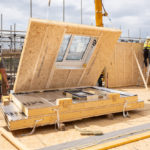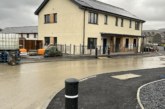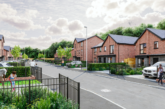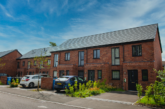Which is safest: masonry or open panel timber frame built with a forklift or more advanced panelised modern methods of construction (MMC) using a crane? That question is explored in a new study prepared by Stewart Milne Group, lead partner in the Advanced Industrialised Methods for the Construction of Homes Innovation Project (AIMCH). The study concludes all methods are safe, but have differing health and safety risk profiles, with crane erect panelised methods, providing 20% less exposure to health and safety risks on site.
The £6.5m collaborative R&D AIMCH project seeks to industrialise how homes are constructed by mainstreaming the use of panelised MMC methods. Previously AIMCH research has demonstrated how utilising panelised MMC systems would result in new homes being built faster, cost effectively, to a high quality and with a lower carbon footprint. This latest study strengthens the case for panelised MMC by concluding that housing sites using panelised MMC systems could reduce onsite health and safety risk exposure by 20%.
Increasingly, panelised MMC systems are being used to build new homes that have progressively more pre-manufactured elements such as prefabricated floor cassettes, pre-fitted windows, and pre-insulated closed walls. These systems require a crane to offload and position the components on site.
The study, Health and Safety Risk Profiling of MMC Solutions, prepared by Stewart Milne Group, with support from Limberger Associates, AIMCH project managers, assessed the difference in risk exposure between two timber frame systems: one built on site using manual assembly techniques with the aid of a forklift (GEN1), also typical of masonry-built homes; the other a more advanced MMC system (GEN3), using higher levels of prefabrication, requiring the use of a crane on site.
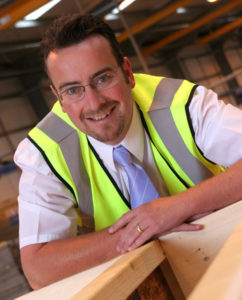 Stewart Dalgarno (pictured left), AIMCH Project Director and Director of Innovation & Sustainability at Stewart Milne Group said: “This is the first study we have undertaken to compare the health and safety risk exposure of both construction methods and it is gratifying to see that the crane-erect panelised MMC methods championed by AIMCH reduce safety risks and hazard exposure by 20% on site, where the injury rate per 100,000 workers is 42% higher than in manufacturing, and where 50% of deaths are attributed to falls from height, compared with 16% in manufacturing.”
Stewart Dalgarno (pictured left), AIMCH Project Director and Director of Innovation & Sustainability at Stewart Milne Group said: “This is the first study we have undertaken to compare the health and safety risk exposure of both construction methods and it is gratifying to see that the crane-erect panelised MMC methods championed by AIMCH reduce safety risks and hazard exposure by 20% on site, where the injury rate per 100,000 workers is 42% higher than in manufacturing, and where 50% of deaths are attributed to falls from height, compared with 16% in manufacturing.”
The study undertook two deep dive evaluations of working practices and techniques in two areas, floors, and windows, where increasing the Pre-Manufactured Value (PMV) is likely to become commonplace. The study developed a methodology for assessing risk, aligned with Health and Safety Executive (HSE) hazard classifications, and consequential risk profiles were developed for each. These covered hazards such as falls from height; slips and trips; moving and handling loads; and lifting operations and were used to compare the effect of onsite working practise differences between GEN1 site assembly and GEN 3 prefabricated construction methods.
The first of these, which compared forklift and loose joists (GEN1) against prefabricated floor cassettes and crane (GEN 3), identified a fundamental health and safety improvement between the two methods: loose joists rely on more manual labour and material movement on-site and the installation of a safety decking system, whereas the use of floor cassettes dispenses with the need for safety decking and significantly speeds up the installation process, removing many of the health and safety exposure risks such as trips and falls, manual handling, material movement associated with loose joist and flooring installation.
When looking at the second category, forklift and site-fitted windows against crane and factory-fitted windows, the latter was found to reduce health and safety hazard exposure, especially applicable with manual handling of heavy components and moving materials, which is a known contributory factor to musculoskeletal disorders.
In both areas the utilisation of GEN 3 systems transfers some of the health and safety risks from the construction site to the MMC factory, where workplace safety systems are generally better managed. However, a heavier reliance on the use of cranes introduces an increased risk of a high impact safety event occurring, such as floor cassettes
breaking their slings and slipping off the end of the bearing when being placed. This is a risk, albeit low, requires strict safety protocols to be in place.
To ensure that the transfer of risk from the construction site to the factory does not lead to an abdication of risk management, the report emphasis the important of MMC suppliers investing in safer and more productive factory techniques that eliminate manual working hazards through mechanical handling, automation, and robotic applications, as well as through standardisation of processes and components.
The report also urges procurers of MMC systems to ensure effective controls are put in place so that an overall net safety gain is realised.
Tim Limberger, Limberger Associates Director and AIMCH Project Manager, said: “AIMCH partners have built several homes using both methodologies discussed in this report to prove the case for scaling up panelised MMC systems, using increased pre-manufactured value (PMV).”
“AIMCH focus is on building a weatherproof, insulated, and secure structural shell in just one day, ideally with no scaffolding and a pre-tiled roof. This requires the use of a crane and the increased utilisation of the current and future panelised MMC solutions. And, although this study examined only two areas of pre-fabrication, we believe that further offsite methods such as bathroom and en-suite pods and external non masonry claddings could also yield similar future benefits — speed of build, lower cost and a safer working environment.”
In addition to the health and safety benefits, the study pointed to the following as benefits of utilising GEN3 crane erect panelised MMC systems:
- Wind and watertight in a day
- Internal and external works can commence immediately after lift day
- Stair access immediately after timber MMC system erected
- All heavy items fitted or pre-loaded within home, ready to use
- Tidy presentable site, with free movement of traffic, after lift day
- No kit stored on site/plot/compound
- No safety deck to erect/dismantle/move and check/supervise
- Customer can walk through home (if desired), soon after shell erected
- Smaller forklift, reduce movements and elimination of long toes
- Forklift freed up for other things
- Less damage and delay due to weather or material delays
- Less dependent on skilled erectors & manual working
- Site working practises much improved
- Reduced manual handling, working at height, material handling and site traffic
- Commercially competitive
- Improved construction predictability & programme reliability
- Reduces overall build programme, saving prelim costs
- Provides capacity to erect two timber frames per week
- Improves front-end work planning, site organisation and upfront thinking
www.aimch.co.uk/outputs provides full details of the Health and Safety Risk Profiling of MMC Solutions report, including the risk profiling methodology employed.

